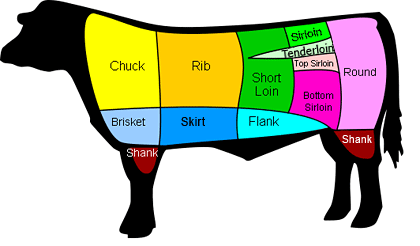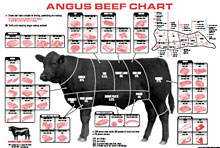All Things Beef
The Beefy Basics
When you order a quarter of beef, the butcher will process the entire half, and then split the cuts between the two quarters, so both buyers get an equal share of various cuts. Because there is only one Flank Steak and one Brisket per half, the first buyer to call in gets their preference between those two cuts.
The beef is sold per pound hanging weight. The per pound cost changes from year to year with the cost of feed and the steers themselves. There will be about a 10% weight loss to bone and fat during the cut-and-wrap process. When the beef is picked up from the butcher, there is an additional ~$.60/lb paid directly to the butcher for the cut and wrap, and you will get a chance to call in your own cutting order, so can specify what cuts you'd like. See below...
Cutting Order Intro
The most tender, premium meat comes from areas of the steer's body that get the least exercise. These are the loin and rib cuts, and are usually cooked with dry heat (grilling, broiling, pan frying, etc.) They need to be handled carefully though to not overcook; though Lowline Angus marble efficiently, and the cattle here are given a bit of grain, they are still considered grassfed, and cooking to more than medium-rare can produce a tough cut. For more well done meat, very low temperatures and possibly marinades or cooking in sauces should be used to preserve tenderness.
Muscles the cattle use frequently (the chuck shoulder and rump rounds) will be tougher but flavorful and require slow, moist heat (braising) to give the connective tissues time to dissolve and make the meat fall-apart tender. Regardless of recipe instructions, do not braise Lowline beef at temperatures higher than 300° to get the most tender pot roast you're likely to ever have.

New buyers are often surprised the most by how tender and flavorful the hamburger is and often this is the cut everyone wishes they'd ordered more of. Because it is so good and the uses so versatile, you may consider sending any cuts you don't specifically want to burger; the more quality meat goes into that, the better it gets.
Many cuts can be bone-in or boneless, but cutting away bone always results in some loss of meat, and because Lowline Angus are physically small to begin with, you may want to choose to have most cuts bone-in. Any cuts you don't want (or want less of) you can request be cut for stew meat or ground for hamburger.
Worth a Thousand Words

Click the image to see a
PDF doc of Del Fox's![]() Angus Beef Chart —»
Angus Beef Chart —»
Or see their image of
standard beef cuts »
Del Fox Custom Meats
(360) 629-3723
Longitude N 48° 16.114' • Latitude W 122° 19.881'
7229 300th St NW •
Stanwood, WA 98292 • Map »
www.delfoxmeats.com »
Hours:
Mon-Thurs: 8am-5:30pm • Fri & Sat: 8am-6pm • Sunday: Closed
- Head north on I-5 and take Exit #215
- Take a left at the stop off the exit and go under I-5
- At the T, take a right
- Then an immediate left onto 300th St NW
- Go a couple miles, and after the 4-way stop at 68th Ave NW, look for Del Fox a half block up on the right.
Recommended Cuts for Quarter-Side of Lowline
Here is the ![]() Del Fox cutting order form Word doc which you can fill out and fax to them or just use for reference and call in your info which is more reliable. If you fax, please follow up with a phone call to confirm that they got your info.
Del Fox cutting order form Word doc which you can fill out and fax to them or just use for reference and call in your info which is more reliable. If you fax, please follow up with a phone call to confirm that they got your info.
Here are the more common cuts and choices to make:
Short Loin
- T-Bones or New York Strip and Tenderloin (a t-bone steak consists of a Tenderloin and a New York Strip joined by the t-bone. Some people prefer to have those cuts separated and bone removed, but you will lose some meat in the trimming, and because Lowlines are smaller cows, separated cuts will be pretty small.)
Sirloin
- Top Sirloin Steaks
- Tri-Tip Roast
- Kabobs or ground for hamburger
Chuck
- Chuck Shoulder Pot Roasts, boneless or bone-in
- Chuck Steaks, Arm Roast, stew meat, or hamburger
- Short Ribs or ground for hamburger
Rump Rounds
- Top Round: Steak and/or Roast. The Top Round is generally more tender than Bottom Round and great for braising (cooking with liquid) as for Strogonoff or classic pot roasts.
- Bottom Round and Eye. Generally these cuts are done as cubed steak or ground for hamburger.
Rib Cuts
- Ribeye Steaks (after the T-Bones, these are most tender) or Rib Roast (Prime Rib). For a Quarter, you'll need to choose one or the other.
- Ribs
Skirt/Plate
- Skirt/Plate Steak (excellent for marinating)
Shank
- Cross Cut Shank (as for osso buco or soups and consommés)
Trim and Misc
- Trim and any cuts you don't want can go toward stew meat or hamburger
- Soup Bones: yes or no
- Stew Meat: yes or no
- You can also request some cuts be wrapped for kabobs, stir fry, fajitas
Either/Or: (there is one Brisket and one Flank Steak per side of beef, so each quarter-order gets one or the other based on who calls in their preference first.)
- Flank Steak
- Brisket (plain or seasoned for corned beef)
Hamburger
- Again, this is often the surprise favorite cut for its flavor, tenderness and versatility, so people often wish they'd sent more to burger. For sure get the prime cuts, and the braising roasts and stew meat are wonderfully tender and well worth getting if you cook those, but otherwise, unless you know you want specific cuts, you might consider sending more to hamburger.
Example Order — My Usual Cut & Wrap Instructions
- T-bone steaks, bone-in, 1", 2 per package. You can get thicker cut steaks, but remember these are small-framed cattle, so one quarter will likely produce two Hollywood-thick steaks or 5-6 1" ones... This is why they're so expensive at the store — even on giant Angus, the tenderloin is scarce.
- Ribeye steaks rather than Prime Rib Roast, bone-in; I've done the roast too, and it makes for an outstanding special occasion dinner, especially when dry roasted at a very low temperature.
- 2 or 3 packages of Sirloin steaks, one Top Sirloin roast, and one Tri-Tip roast with the rest of the Sirloin going to hamburger
- Cross-rib Roast — particularly good braising roast (this comes from the shoulder/chuck area of the steer so is different from the Rib Roast/Prime Rib and should be treated as a pot roast and braised -- cooked in liquid at very low heat for several hours at which point it becomes fall-apart tender.)
- 2 each of Chuck Roasts and Top Round roasts with the rest of the chuck, top round and all of the bottom round going to hamburger
- 2 or 3 packages of stew meat
- Brisket over flank steak — just a personal preference, though both are excellent
- Soup bones

